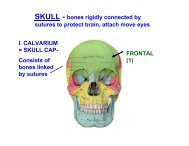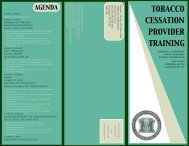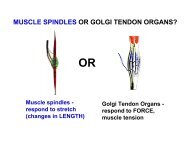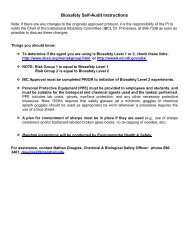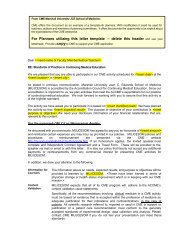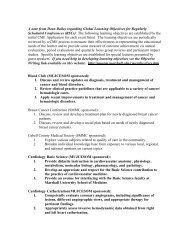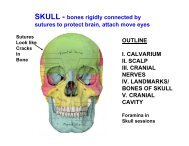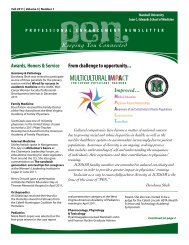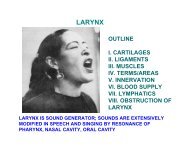FA 5 Progress Report WV-INBRE - Joan C. Edwards School of ...
FA 5 Progress Report WV-INBRE - Joan C. Edwards School of ...
FA 5 Progress Report WV-INBRE - Joan C. Edwards School of ...
- No tags were found...
You also want an ePaper? Increase the reach of your titles
YUMPU automatically turns print PDFs into web optimized ePapers that Google loves.
Program Director/Principal Investigator (Last, First, Middle): Rankin, Gary O 39KINETIC AND MOLECULAR DYNAMICS CORRELATIONS IN CYTOCHROME P450(0023)TYPE:Research Subproject%IDeA $: 5.000% IDeA $: 172,385INVESTIGATOR, DEGREEAguilar, Jarrett PHDGannett, Peter PHDDEPARTMENTNatural Science &MathematicsBasic Pharmaceut SciNON-HOST INSTITUTION: STATE,COUNTRYWest Liberty University, Wv UsaWest Virginia University, Wv UsaTotal # human subjects expected for entire study: 0Total # human subjects enrolled to date: 0SUBPROJECT DESCRIPTIONThe cytochrome P450 enzymes mediate the metabolism <strong>of</strong> various xenobiotic and endogenous compoundsand can bioactivate pro-carcinogens such as benzo-[a]-pyrene. Many drug-drug interactions are caused bythe effect <strong>of</strong> one <strong>of</strong> the drugs on the activity <strong>of</strong> the P450 is<strong>of</strong>orms involved in the metabolism <strong>of</strong> the seconddrug. Some is<strong>of</strong>orms demonstrate atypical kinetics for the metabolism <strong>of</strong> certain substrates. We and othershave suggested that simultaneous binding <strong>of</strong> two substrates in the active site (a two-site model) isresponsible for most atypical kinetic pr<strong>of</strong>iles. Dapsone and structurally related substrates, have been shownto activate CYP2C9 metabolism <strong>of</strong> flurbipr<strong>of</strong>en, naproxen, and piroxicam. The kinetic data suggest bothsubstrate and activator are present in the active site. CYP2C9 polymorphisms result in reduced enzymecatalytic activity and greater activation by effector molecules as compared to wild-type protein, with themechanism(s) for these changes in activity not fully elucidated. The molecular dynamics for severalmutations involving key sites for possible catalytic activity will be studied by molecular dynamics and theresulting kinetics data will be compared to determine if these key sites are responsible for the changes inactivity between various mutants <strong>of</strong> CYP 2C9. The mutations will be prepared via site directed mutagenesis,and the enzyme expressed and purified for kinetic analysis. Kinetic analysis will be conducted using anHPLC with a fluorescence detector. The data obtained will be compared to that obtained from the moleculardynamics data for same mutations. The distance between the active H <strong>of</strong> the substrate and the heme ironappears to be important to substrate metabolism. The kinetics for these mutations will be compared tothese distance changes and correlations between the two studied. The mutants are R108I and N204I asthey are responsible for substrate binding within the active site. Other mutants E300I, S209A, T304A, andN474I will be studied as they may determine binding orientation <strong>of</strong> the effector. This will provide informationthat would allow one to control the kinetics by proper choice <strong>of</strong> substrate and effector and provide a greaterunderstanding <strong>of</strong> the active site mechanism <strong>of</strong> cytochrome P450 2C9.SUBPROJECT PROGRESSWe first had an issue with our site-directed mutagenesis and our plasmid became smaller than that<strong>of</strong> our wild type protein. We attempted many measures to circumvent this problem and determinedto sequence the plasmid. It was noted after many trials that we were missing a Lac I repressor. Thiswas decided would not effect our project as our soul purpose for the plasmids was to produceprotein. The missing LacI only meant the expression <strong>of</strong> CYP2C9 was always on without control.This is no longer an issue and site directed mutagenesis has been used successfully to generate all<strong>of</strong> the mutants that are presented in this proposal.The expression <strong>of</strong> mutants has been an even greater time consumer. The expression <strong>of</strong> mutatedprotein is a 3 day process in which the protein content must be constantly monitored. It is an issuethat many 3 day trials are unsuccessful at producing the mutated proteins. The most viable reasonthat we can deduce is that many mutations <strong>of</strong> proteins can be toxic to the cells. In many cases thismeans we may not be able to express these mutations. We have recently taken steps to usechaperones to assist in protein folding as to minimize the toxicity <strong>of</strong> the mutated proteins. We havebeen able to express several <strong>of</strong> the mutations and working on getting the chaperones into thosePHS 2590 (Rev. 06/09)Continuation Format Page



